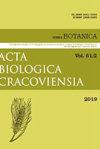Ovules, Female Gametophytes and Embryos are More Sensitive to Heavy Metal Pollution than Anthers and Pollen of Cardaminopsis Arenosa (L.) Hayek (Brassicaceae), A Member of Calamine Flora
IF 0.5
4区 生物学
Q4 PLANT SCIENCES
引用次数: 9
Abstract
Reproductive processes including male and female lines, embryo and endosperm development were studied in Cardaminopsis arenosa (syn. Arabidopsis arenosa ) growing on two metalliferous sites (Bukowno and Bolesław, S. Poland), rich in Zn, Pb, Cd and other metals. Disturbances of developmental processes and necroses observed in anthers and ovules influenced plant fertility and seed set of plants from both metal-polluted sites. In anthers, disturbances and necrosis during male meiosis and pollen development occurred at low frequency (4–5%). Pollen grain viability was very high, reaching over 90%. In ovules the frequency of abnormal meiosis, female gametophyte developmental disturbances and necrosis was high, 23.5–28% depending on site. The polluted envi- ronment also affected embryo and endosperm. Necrosis of whole generative structures decreased plant fertility. This study indicates that the range of disturbances and necroses in embryological structures and processes (at gametophyte level) gives a set of useful characters to determine plant tolerance to stress, complementary to many tolerance characters at the sporophyte level of plant ontogenesis.小豆蔻的胚珠、雌配子体和胚胎对重金属污染的敏感性高于花药和花粉海耶克(芸苔科),炉甘石植物群成员
研究了在布科诺(Bukowno)和Bolesław (S. Poland)两个富含锌、铅、镉等金属元素的土壤上生长的砂南芥(Cardaminopsis arennosa)的生殖过程,包括雄性和雌性系、胚胎和胚乳的发育。在两个金属污染地点,花药和胚珠发育过程的紊乱和坏死影响了植物的育性和结实率。在花药中,雄性减数分裂和花粉发育过程中出现干扰和坏死的频率较低(4-5%)。花粉粒活力很高,可达90%以上。在胚珠中,减数分裂异常、雌配子体发育障碍和坏死的发生率高,依部位而定,为23.5-28%。环境污染对胚胎和胚乳也有影响。整个生殖结构的坏死降低了植物的肥力。本研究表明,在配子体水平上,胚胎结构和过程中的干扰和坏死范围为确定植物对胁迫的耐受性提供了一套有用的特征,补充了植物个体发生过程中孢子体水平上的许多耐受性特征。
本文章由计算机程序翻译,如有差异,请以英文原文为准。
求助全文
约1分钟内获得全文
求助全文
来源期刊
CiteScore
3.00
自引率
0.00%
发文量
0
审稿时长
>12 weeks
期刊介绍:
ACTA BIOLOGICA CRACOVIENSIA Series Botanica is an English-language journal founded in 1958, devoted to plant anatomy and morphology, cytology, genetics, embryology, tissue culture, physiology, biochemistry, biosystematics, molecular phylogenetics and phylogeography, as well as phytochemistry. It is published twice a year.

 求助内容:
求助内容: 应助结果提醒方式:
应助结果提醒方式:


